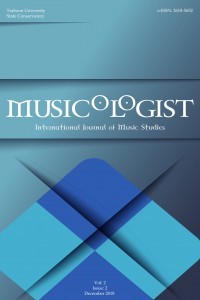On the Evidence that Confirms the Continuity of Georgian Chant Tradition
On the Evidence that Confirms the Continuity of Georgian Chant Tradition
chant, music, neumes ecclesiastical,
___
- Gvakharia, Vaja. (1978). Miqael Modrekili – Gimny. Tbilisi: Sabchota Sakartvelo.
- Gvakharia, Vaja; Shugliashvili, David and Razmadze, Nino. (2013). Description of the Manuscripts and Alphabet Catalogue of Georgian Sacred Hymns, Tbilisi: Megobroba.
- Ingorokva, Pavle. (1958) “The Decipherment of Georgian Antique and Medieval Musical Notation and the Restoration of Old Georgian Music”. Journal Mnatobi. 2: 124-174.
- Oniani, Ekaterine. (2016) “On the Revealing the Basic Compositional Principe of Chants in Neumatic Notation”. Folk and Church Music Issues, Ed. Khatuna Managadze: pp. 91-106 Batumi.
- Tsereteli, Zaal. (2004). “The Possibility of Interpreting Ancient Georgian Musical Notation through 19th Century Transcriptions”. International Symposium on Traditional Polyphony. [Paper presented at the 2nd International Symposium on Traditional Polyphony on September 23-27, Tbilisi, Georgia] Tsurtsumia, Rusudan and Jordania, Josef (Eds.), (pp. 374-387). Retrieved from https://drive.google.com/file/d/1HJkO-yaWNVYGfpIKVGsjtQSzaGEQIr-n/view
- Tsereteli, Zaal. (2008). “Deciphering the Old Georgian Neumatic System and Ways of Re-introducing it into Practice”. International Symposium on Traditional Polyphony. [Paper presented at the 4th International Symposium on Traditional Polyphony on September 15-19, Tbilisi, Georgia] Tsurtsumia, Rusudan and Jordania, Josef (Eds.), (pp. 516-530). Retrieved from https://drive.google.com/file/d/1FLWQVdWE-Jf3ddTS2DxM3j8R9oke9_4T/view
- Yayın Aralığı: Yılda 2 Sayı
- Başlangıç: 2017
- Yayıncı: Trabzon Üniversitesi
On the Evidence that Confirms the Continuity of Georgian Chant Tradition
Emel Funda TÜRKMEN, Mete GÖKÇE
Microtonal Guitar Culture in Turkey
New Additions to the Guitar Family: Lego and Automatic Microtonal Guitars
Ruşen CAN ACET, Batuhan BAŞAR, Tolgahan ÇOĞULU, Atlas ÇOĞULU, Tony ITALİA, Selçuk KESER
A Comparative Study of Ogu Mase Music of Akarakumo and Lagon-Thogli in Badagry
